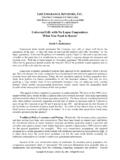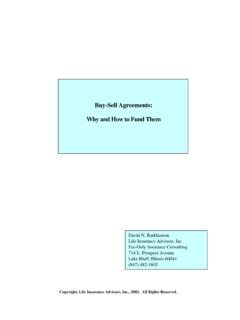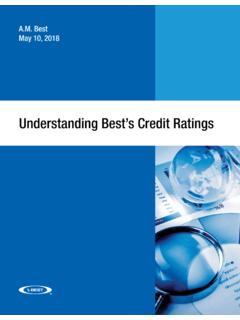Transcription of What Sophisticated Investors Should Know and …
1 Copyright, David N. Barkhausen, 2001. All Rights Sophisticated InvestorsShould know and Askabout Life InsuranceDavid N. BarkhausenLife Insurance Advisors, Insurance Consulting714 E. Prospect AvenueLake Bluff, Illinois 60044(847) 482-16052 what Sophisticated InvestorsShould know and Askabout Life InsuranceTable of ContentsTopicPageComparing Companies 5 Company ratings and Rating Agencies 6 Comparing Products as well as Companies 7 Permanent Insurance: Reviewing Its Rate of Return 8 The Four Factors Affecting Rate of Return 11 The Impact of Agents Commissions 10 The Investment Potential of Life Insurance 18 Comparing Whole Life and Universal Life 19A Comparative Analysis Involving Variable Life 20 The Reverse Engineering Analysis of Insurance Policies 21 Salvaging or Replacing Underperforming Policies 22 The Danger of Underfunded Policies 23 Considerations and Precautions in Replacing Policies 24 Insurance Underwriting for the Health-Impaired Client 26 The Role of a Fee-Only Life Insurance Advisor 273 what Sophisticated InvestorsShould know and Askabout Life InsuranceExecutive life insurance products ( , whole life)
2 Are not fungible. Their rates ofreturn vary substantially one from the other, as does the financial strength of thecompanies offering them. Expert and objective help is needed to sort out Consumers Should not rely on policy illustrations as the basis for choosing betweeninsurance companies. The choice Should be based on a combination of an insurer sfinancial strength, the historic rate of return that its policies have offered, and a provenrecord of treating its policyholders fairly (pages 4-7). A 1996 actuarial study revealedthat only 2 of 28 companies projecting the most favorable results satisfied currentregulatory requirements for illustration Policy performance depends on four factors: gross investment returns, mortalitycharges, expenses, and policy persistency (lapse rates).
3 Even for products with similarinvestment results, differences in the other variables dramatically affect long-term ratesof Looking at the variable of mortality charges alone, a recent Society of Actuaries studyfound that the difference between the best results from one company vs. the meanresults for 22 other leading companies improved long-term rates of return by 90 to 140basis points depending on the age of the It is often possible to structure the components of a permanent insurance product toreduce the traditional agent s commissions by approximately 85 percent. This, too, canimprove the long-term rate of return of a policy by 1 percent or A low-load life insurance policy with the most competitive mortality and expensecharges offers an attractive investment opportunity in comparison with similar taxableinvestments.
4 Removing 85% of the commission cost and obtaining top mortality resultscan improve rates of return by 200 basis points, or 43%, over the returns from anaverage policy with a standard commission (pages 14-15; see charts on pages 16-17). With such a policy, even if the dividend interest rate were to decline by 1 percent belowthe current rate and the insured were to live to age 95, the tax-free rate of return wouldbe percent. With combined federal-state tax rates of between 30% and 40%, thetaxable equivalent rate of return for this low-risk, fixed income investment would rangebetween 9 and 11 With both existing and new policies, it is possible to reverse engineer policyillustrations to analyze and gauge the credibility of their projections.
5 This processenables a forecast of a policy s range of potential outcomes and a comparison withalternatives that might offer better A high percentage of existing permanent life insurance policies will self-destructbefore the death of the insured, wreaking havoc with estate and business planning thatassumes the continuation of this coverage. Many of these policies were sold with lowball premiums designed to beat the competition that are insufficient to deliver theexpected death benefit, in light of lower interest rates and higher insurance chargesthan those used in the original policy sales illustration. Corrective action, which mayinclude the replacement of the original policy, is required to keep these policies aliveand, perhaps as well, to obtain much better returns for the premiums Increasing capacity in the reinsurance market has raised the likelihood that those withhealth impairments can obtain insurance on a favorable basis from the best insurancecompanies.
6 Informal underwriting inquiries can be made to determine the likelihood ofacceptable A fee-only life insurance advisor can provide cost-effective advice whenever a policy sannual premium equals at least $5,000 - $10,000 or when the cash value of an existingpolicy amounts to at least $50,000 - $100, INSURANCE ADVISORS, INSURANCE CONSULTING714 E. PROSPECT AVENUE LAKE BLUFF, ILLINOIS 60044 PHONE (847) 482-1605 FAX (847) Sophisticated InvestorsShould know and Ask About Life InsurancebyDavid N. BarkhausenThe recent failures of large life insurance companies -- M utual Benefit and Executive Life in 1991and Confederation Life in 1994 -- sent tremors throughout the life insurance industry and causedsop histicated Investors and those who work in an advisory cap acity with life insurance p roducts to take acloser look at both the strength of the companies and the nature of the p somewhat less obvious but also more widesp read p roblem is the extent to which p olicies sold inthe last 20 y ears have failed to come close to matching the p rojections made in the illustrations used to sellthem.
7 Who is monitoring p erformance, and what action Should be recommended where it has fallen wayshort of p rojections? The viability of y our estate and business p lans may be at stake if an existing p olicyfizzles out before y our death of the insured (or the survivor of y ou and y our sp ouse in the case of second-to-die p olicies).Purchasers or owners of large amounts of life insurance had better hop e that they have an unsuallygood life insurance advisor. They are ap t to get little in-dep th, p roduct-related advice from any one else. While some lawyers, accountants, and trust officers have a decent understanding of life insurance, most ofthem do not, and even those who do may be reluctant to venture a candid op inion for fear of liability or ofgiving offense to a friendly insurance p remise of this article is that those whose estate and business p lanning dep ends onexp ectations that a life insurance p roduct will p erform as illustrated need an objective analy sis whenchoosing from among companies and p roducts or when assessing the p erformance of insurance alreadyowned.
8 Those with a little p atience will find that this p rocess is not hop eless guesswork but, in fact, has aclear-cut logic to it. The following guide Should be helpful in analy zing existing coverage as well as newpolicies, at least by suggesting what questions to ask. Comparing CompaniesAll insurance companies are not alike. Both in their financial strength and rate-of-returnperformance, they are very different. It is therefore important to be armed with the basic informationnecessary to distinguish the good from the bad and even the best from the good and, in the case ofexisting insurance, to spot problems with current policies. Policy ratings and rates of return are readilymeasurable and capable of comparison, one against the other, and, to the extent your clients are in aposition to do so, there is no reason not to choose the meaningful comparisons between life insurance companies does not require the insightof an actuary, the most Sophisticated techniques of financial analysis, or even the knowledge of themost technically oriented life insurance agents.
9 It is really just a matter of knowing what questions to6ask about life insurance company ratings and the factors that determine a product s and carrier shistoric rate of return. Here is the background that begins to equip you for the Insurance Company ratings and Rating Agencies: Any analysis of a new or existingpolicy Should begin with a review of the financial strength ratings of the company in question. Today,there are five rating agencies: Best, Standard & Poor s, Moody s, Fitch (previously Duff &Phelps), and Weiss Research. For years, A. M. Best had the field to itself. However, as large pensionfunds investing in the guaranteed investment contracts of life insurance companies sought additionalmeans of tracking the safety of their investments, S&P, Moody s, and Fitch -- all firms with a historyof issuing credit ratings -- entered the insurance rating business as well.
10 Weiss is the most recentaddition to the group and is known for its critical and wholly quantitative Best and Weiss rate all life insurers of any meaningful size. A company has to choose tobe ranked by the other three agencies. Because it takes the time of top management to undergointerviews with and respond to requests for information from the examiners and perhaps because theremay be a reluctance to face the additional scrutiny, some choose to forgo a review by one or more ofthis group of three. The absence of a rating, however, makes it more difficult for a company tocompete with insurers who have favorable grades from all of the number of companies reviewed and the number receiving the top rating from each of theagencies is as follows, according to the September, 2001 edition of The Insurance Forum: Best:1,353, 65; Moody s: 200, 12; Standard & Poor s: 852, 38; Fitch: 219, 41; Weiss Research: 1,158, 6.









